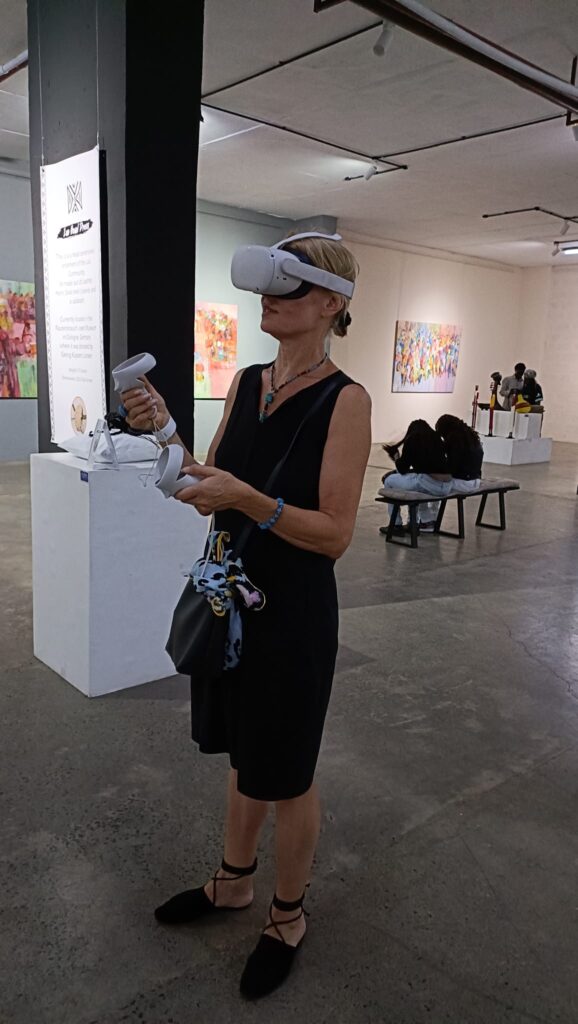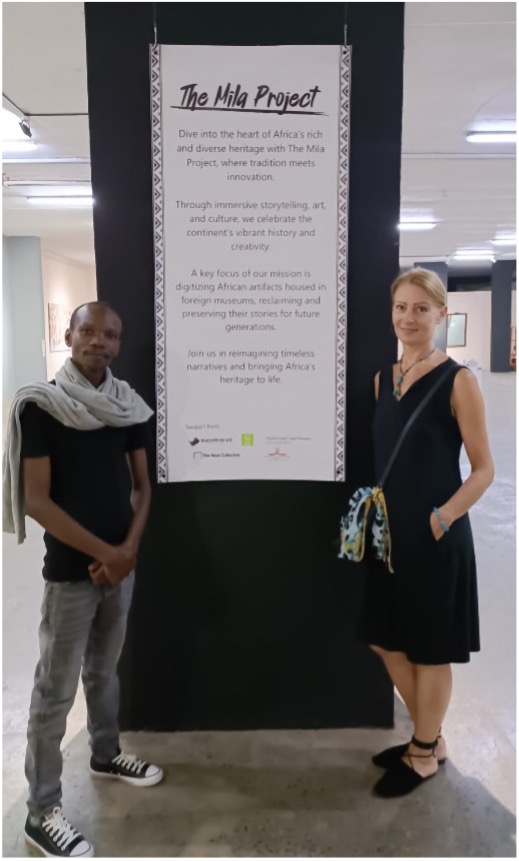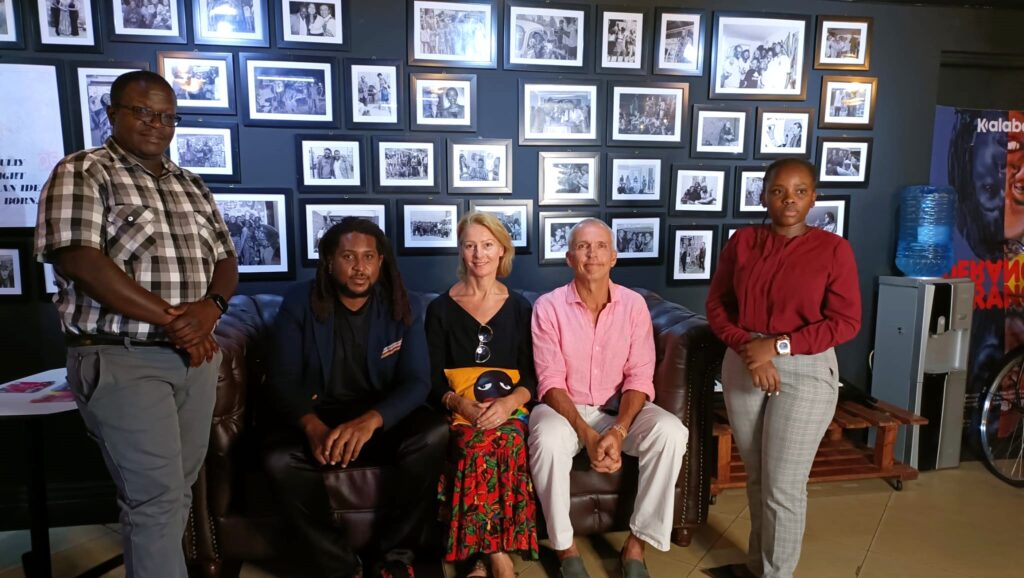Researchers from the Polish Society for Aesthetics in the CAPHE Consortium, Marlena Chybowska, and Rick Butler, took the pulse of the 4IR tech landscape in Nairobi during their second research stay in Kenya in November 2024. They found notable changes and new projects that have recently surged in the Kenyan capital.
They focused on://
· the documentation of the use of AI by Kenyan creatives in the form of a recently released report by the Creatives Garage (CG) non-profit organization,
· the demise of the Black Rhino VR consultancy that disbanded in the wake of founder Bryan Afande’s (BF) and his family’s move to Europe,
· the debut exhibition of the Mila Project, which uses a combination of VR experience and 3D printing to address both education and restitution issues of Kenyan artifacts held in museums outside Africa.
The researchers also met with Lyosi Mwedeleki (LM) of the Hutchery VR production house and consultancy, which is working with UN agriculture and immigration offices to create training experiences for Kenya and the region, and they attended a tour and artists’ talk with Mumbai-based game designer Sahej Rahal, whose exhibition at the Nairobi Contemporary Art Institute incorporates AI.
Creatives Garage AI Report
Released in July 2024 by the organization that conducts education and training programmes aimed at helping Kenyan creatives to tell better stories, ARTificial Intelligence in Africa: Investigating the Impacts of AI on the Creative Community in Kenya contains more than 250 pages of information about the way culture producers are using the technology.
Sponsored by a grant from the US-based Mozilla Foundation of open-source web browser fame, the report is culled from a survey, a pair of focus groups, and interviews that together engaged 130 creatives, who were asked about the attitudes toward AI in the country that’s being referred to in tech circles as the Silicon Savannah.
Key findings include:
· Actors, writers, illustrators, graphic designers, musicians, and other creative professionals regularly use deep learning and generative AI tools like Midjourney and ChatGPT.
· While users say that AI is improving productivity, they are concerned both about its effect on employment and about the capacity for appropriating their intellectual property.
· Although the government has recognized the significance of the tech and creative economies that together contribute around 12 percent to the country’s GDP, discussions about regulating AI and IP protections are being subsumed by perceived threats to cyber security.
CAPHE researchers spoke with Stephen Collins (SC), who is the general manager of the 11-year-old non-profit that draws the bulk of its funding from international sources. And with Mercy Nyaga (MN), the organization’s director of growth. Over the course of an hour, they described the scope of the report, which contains sections on AI’s penetration on the continent and in the region in order to locate the use of the tech in a Kenyan context.
According to SC, the research aims to highlight the opportunities and dissect the threats that AI presents for Kenyan creatives, who expressed in surveys and focus groups their uniform desire for fair and ethical treatment of users in the industry. In the main, they believe that the benefits outweigh the threats posed by AI’s thus far unbridled use in creative fields.
“Creatives in Kenya view AI as a source of advantage as it saves time,” MN says, highlighting assistance with the fleshing out of ideas as one such popular use of the tech. “In areas like graphic design, they can input images to generate new ideas that make their images better.”
In addition, she says, creatives are using AI for skills development. And, they are beginning to train their own models in order to more specifically apply the technology in a local context. SC added that the amount of data creatives have put into large-language models used to train AI engines at work in the various creative industries has grown exponentially over the last two years.
“We have organizations and creatives in the country that are working to create AI systems,” he says. “So, increasingly, they are better able to contextualize the AI outputs for their respective industries.”
The report describes the tensions caused by the efficiencies the technology enables and the potential for disenfranchisement of workers in creative fields. It also examines the potential for democratizing the creative industry against the threat of inequality for those with limited access to AI platforms and tools.
CG sees its research findings as a foundation on which Kenyan creatives can engage with policymakers about AI development and governance. By highlighting issues and challenges, the group hopes to influence the legislative approach in forging a regulatory framework that can create robust protections for intellectual property in creative work.
“At government level, there is more concern about cyber security than about creating a framework that protects creatives and their intellectual property,” Collins says, noting CG launched a podcast called Onega AI in March that explores aspects and applications of the technology in the spectrum of creative industries.
“And that’s a concern that appears overblown in light of the threat. When creatives engage with legislators, they stress the need to protect their work. Even as creativity can thrive when anything goes, the Kenyan market needs regulation for the equitable use of AI in creative industries.”
Creatives Garage – AI/KE Report 2024
Bye-Bye, Black Rhino?
During the visit to CG’s newly acquired space in The Mall at Westlands, where CAPHE researchers had attended VR demonstrations during the first Nairobi secondment in 2023, Black Rhino’s offices were nowhere to be found. In conversation with LM, our researchers learned that the agency’s founder had followed his Dutch wife to Amsterdam and is continuing to coordinate activities that range from the provision of VR services in Africa to acting as a member of the World Economic Forum’s Metaverse Council from his new base in Europe.
According to LM, who got a call from BA informing of the decision, Black Rhino laid off staff and shut its doors in March. LM said BA asked whether he wanted to collaborate with Black Rhino in an on-the-ground management capacity. While LM said he preferred to continue on his own in the provision of VR experiences in the fashion and other industries, he noted that Black Rhino still services clients in Kenya and elsewhere in Africa with contract staff.
The closure of the company’s Nairobi office after nine years speaks more about BA’s opportunities and family commitments in Europe than it does about 4IR technology’s prospects in Kenya. This even as LM pointed researchers to a report by the American television news magazine 60 Minutes that detailed abuses by contractors to US-based giants like Meta and Tesla of lowly paid Kenyans who work tagging images for the libraries those companies are using to train AI computation engines.
The Mila Project
CAPHE researchers attended the opening of an exhibition that showcases a novel use for 4IR technologies. The Mila Project’s Two Worlds, One Gallery, which debuted in November at the Ardhi Gallery in southwest Nairobi, demonstrates how they can be employed to address issues over the appropriation of artifacts that linger from the Colonial Era.
Comprising a VR experience that enables viewers to manipulate rendered artifacts and handle 3D-printed facsimiles of the actual items housed in a German ethnographic museum. The 10 pieces on show range from drums and shields to calabashes and headdresses and are among the more than 14,000 items that Bryan Njeru of the Urban Gurus game producer that developed the exhibition notes reside in institutions outside Kenya.
“Without objects like these to give it context, you will lose touch with your history if enough time passes,” says BN, who trained at Black Rhino for a career in advertising before opening Urban Gurus in 2002.
Built on an inventory undertaken by the Nairobi-based Nest Collective of artists and activists, who in 2017 began petitioning institutions across Europe for lists of objects of Kenyan origin in their collections, Urban Gurus worked with a German consultancy called Shift to model the pieces from Cologne’s Rautensrauch-Joest Museum, which then were printed in Kenya.
Germany’s Goethe Institute helped to underwrite the project, for which Urban Gurus modeled the VR exhibition that takes its design shape from the boma, a shelter used in East and Central Africa both as a place for community gatherings and as livestock enclosures. Viewers use VR headsets and manipulate objects with handsets.
BN sees educational applications for the exhibition similar to those used by the Ukwenza VR, for which Urban Gurus created an experience around recycling. The Nairobi-based social enterprise brought that sorting game to around 50 schools in Kenya.
Our researchers see great potential in the Mila Project, including for exhibition in Poland and elsewhere in Europe. Given that it meets CAPHE goals, they are developing plans to incorporate it into their work for the remainder of the program.



